Twin Bridges-Suspension Bridges
Advantages of suspension bridges:
- Can cover very long spans
- The steel cable used is cheaper than steel beams or girders
Disadvantages of suspension bridges:
SUSPENSION SYSTEM
On a suspension bridge, there are towers
that hold the cables. The towers allow the cable to span long distances. Anchors
help to stabilize the bridge. Primitive suspension bridges were made of twisted
grass and later bridges were made of iron chains. Today large suspension bridges
are made of cables of thousands of wires which are tightly twisted together.
Cables are secured on a heavy block (today made of concrete) to make sure
they cannot break free. The anchors hold the cables that hold the bridges
up.
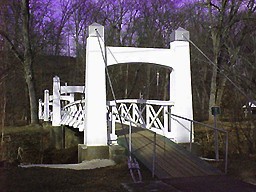 |
|
 |
| The twin bridges in Lenape Park
in Perkasie, PA are the only suspension bridges in the Pennridge School
District. |
|
These bridges were built by the WPA (Works
Progress Administration) along with the island for the bridge bases, arched
bridge on Walnut Street, a dam, and dredging the creek. |
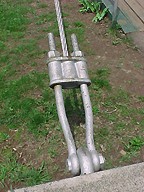 |
|
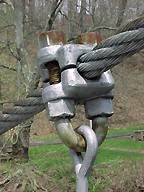 |
|
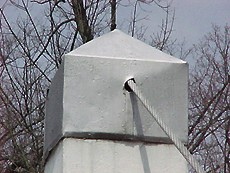 |
| Cables for the suspension system
are tied to a base on each side of the bridge. |
|
The cables are attached to vertical
metal rods. |
|
Two pillars on each side of the
bridge support the cable system. |
 |
|
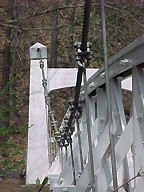 |
|
 |
| Vertical rods are attached on both sides of
the bridge to support beams. |
|
As the cable gets closer to the pillar, the
length of the vertical rod increases. |
|
Note the triangulation at the side of the bridge
supports to increase strength. |
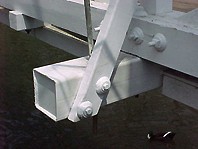 |
|
 |
|
|
| The triangular support is bolted
to the beams that run under the bridge. |
|
Trusses ("X" shaped)
at the sides of the bridge also add strength to the bridge. |
|
Notice the use of additional triangular
braces under the bridge. |
LARGE BRIDGES
Suspension bridges can span distances up to 7,000 feet.
This is much longer than other type of bridge. A suspension bridge suspends
the road above the ground using cables that span across the whole bridge.

